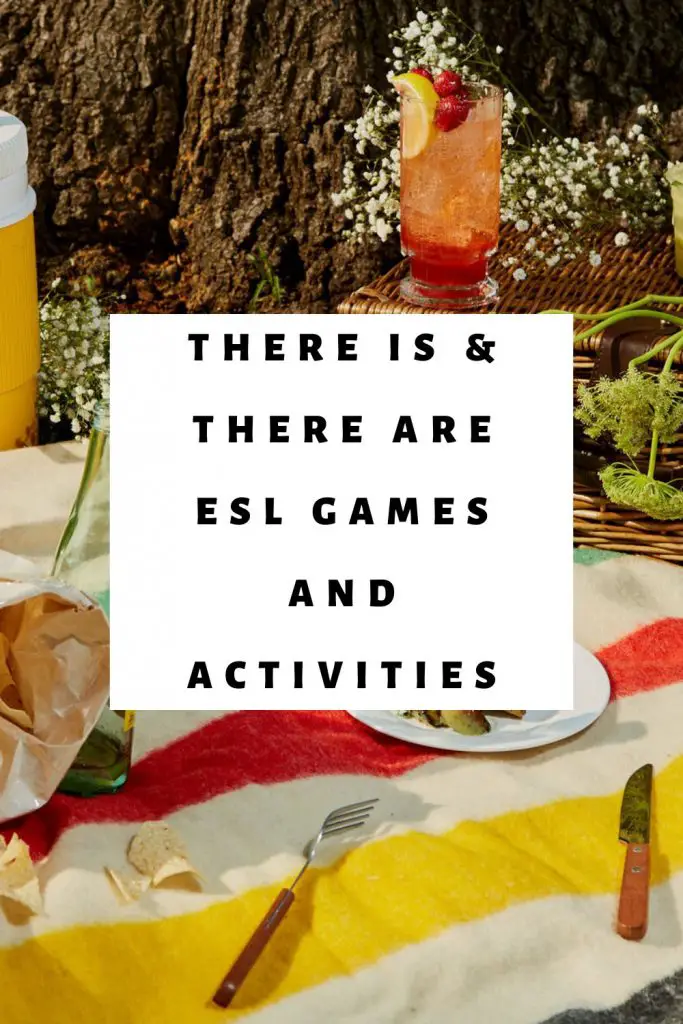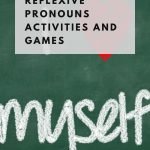If you’re looking for some of the best there is there are games and activities, along with lesson plans, worksheets and online practice opportunities, then you’re certainly in the right place. Keep on reading for all the details you need to know.

There Is There Are Games
Let’s get into the top game and activity recommendations! Have some fun with your English learners by using a variety of engaging lesson plan ideas.
#1: Mixed-Up Sentences
For beginners, a nice way to get them to make some basic sentences with the target grammar is to do this activity. They have to unscramble the words to make a grammatically correct sentence. It can be done alone, in pairs, as a game, on an exam, or for a simple homework activity. It really is that versatile! Learn more about it:
#2: Flashcard Games and Activities for There Is/There Are
For abs0lute beginners, flashcards are a nice way to practice. In this case, get some flashcards that have singular and plural nouns. Students can make sentences. For example:
- There is a cat.
- There are two dogs.
- There are three people.
- There’s a pencil.
There are lots of other ideas too. Check them out: ESL Flashcard Activities.
#3: Dialogue Substitution
Try out this simple activity that turns a dialogue from a basic reading activity into one that can focus on there is and there are. Remove is/are from the passage and students have to fill in the blanks. It’s ideal for a review activity in the next lesson after teaching this concept.
Have a look here:
#4: Ball Toss
This is another game that can create a lot of fun and excitement in the classroom. Use a permanent marker to write there is/there are/there’s on a beach ball.
Then, students have to toss the ball around the class. When they catch it, they have to look and see where their right thumb is. Using that sentence starter, they have to make a true statement about what they see in the class. For example, there are 10 students. The catch is that students can’t repeat statements so it gets more difficult as the game goes on! Try it out:
#5: Dicto Gloss Activity
Try out this challenging listening activity for high-beginner to advanced-level students. It’s fun and a nice way to review just about anything. In this case, include sentences with a lot of the target grammar. Then, read it out at a faster than normal pace. Students attempt to recreate what they just listened to. Find out all the details about it:
#6: Error Correction Relay Race
Why not turn something old (error correction) into something new with this fun relay race? Adding an element of competition to it can really level up the class!
Just make a passage with a number of errors related to there is and there are and students can get to work fixing it up. The key is that each student can only correct one error at a time and must rely on their team to get the job done.
Have a look here at this simple activity to try out with your students:
#7: There Is There Are Videos
I sometimes think that my students get tired of hearing me talk by the end of the semester. That’s why I sometimes like to let other teachers do the heavy lifting and explain the concepts. You can find lots of great videos on YouTube to explain there is/there are to students. Of course, there are plenty of other ideas to use video in the ESL classroom.
#8: Concentration
This is a fun memory game that can be used to practice this concept. Put nouns on one card (a cat, some water, 3 dogs) and there is/there are on the other cards. Students have to find matches that are correct.
The key is that students have to put the cards back into the place they got them from, after showing all the other students what’s on them. This makes it into a memory game instead of just random luck. Learn more about it:
Concentration ESL Memory Game.
#9: Is that Sentence Correct
A quick activity for all ages and levels is this error correction one. Students have to decide if the sentence is correct, or not and if it’s not correct, they have to make the required changes. Find out more about it:
Is that Sentence Correct Activity
#10: Dictation
I know that dictation is a bit old-school but it does have a lot of value for focusing on forms and grammatical structures, along with spelling and punctuation. In this case, dictate some questions or answers that use there is and there are. Students have to write it down, and then answer the question or make the question (depending on what you dictated).
More details about that can be found here: ESL Dictation Activity.

ESL there is, there are activities and games
#11: Brochure Scanning
I love to bring real life into my classroom whenever possible. In this case, I like to use some travel brochures, or whatever you might find that has a lot of the target vocabulary or grammar.
Then, I get students to look at the brochures to find examples of whatever I’m teaching them. We come back together as a class and discuss what the students have found. This is a nice way to lead to more explicit grammar or vocabulary teaching. Find out more:
#12: The Hot Potato Game
If you want to create some fun and excitement in your lessons, then be sure to check out the hot potato game! Students have to pass around an object and then when the music stops, the person holding it has to do a task of some kind. In this case, they could answer a simple question with there is/there are. If correct, they remain in the game. If incorrect, they are out. Check out all the possibilities right here:
#13: The Flyswat Game
If you want to create some fun and excitement in your classes, then you’ll want to check out this game! Put a variety of nouns on the whiteboard. For example:
- 3 bottles of water
- some water
- a cat
- 3 cats
- Etc.
Then, students race to slap one of them with a sentence starter that you give (there are, there is, there’s). Learn more about it:
#14: Proofreading and Editing
Proofreading and editing are some of those boring, but necessary skills for our students to learn! After all, almost nothing looks worse than reading some promo material from a company or an email riddled with errors. Help your students prevent this by learning some basic skills.
Have a look here at how I help my students out with this:
Teaching Proofreading and Editing Skills.
#15: Pictionary or Charades
Try out these fun games with your students! Make up some sentences containing the target grammar and then students have to draw (Pictionary) or act them out (charades) for their teammates who will guess what they are. The key for this one is that students have to say the complete sentence in order to practice the target grammar.
#16: There Is There Are Reading Lesson
It’s easy to plan a reading lesson around this grammar point! There are a few simple steps you can follow. Have a look:
#17: Sentence Structure Games and Activities
There are lots of things you can do to help students build better sentences. And of course, sentences are super important because they are the building block of English! Have a look at some of my favourite ideas here:
ESL Sentence Structure Activities.
#18: Use CCQs
I love to use CCQs (concept checking questions) when I teach basically anything! They help to make sure students really understand the key concepts. Here are some examples:
- 1 cat. Do I use there is or there are?
- There’s 1 cat. What is there’s?
- Water/bottle of water. There is for both of them?
#19: Picture Description
This is a simple warmer activity for teaching this concept. Put up a picture on the screen with lots of singular and plural nouns. Ask students what they see. They may shout “ball.” The teacher can reframe it as, “There’s a ball.” It can easily lead into more explicit teaching about the rules for when to use each form.
#20: Listening Lesson with There Is There Are
A nice way to teach just about anything is with a customized listening lesson. Find a passage with lots of the target grammar and vocabulary and have your students get to work. It’s easier than you might think to plan a lesson like this. Have a look here:
#21: Prepositions
If your students know some basics prepositions of place like in/on/under, then take advantage of it! Have some objects on your desk and students can make sentences using the target grammar. For example:
- There’s a pencil under the book.
- There are some pens in the pencil case.
#22: Drilling Games
Drilling can be quite an effective way to reinforce key grammar or vocabulary concepts in another language. It can work well in this case too with this grammar point. Have a look here for some nice ideas for ESL drilling:
#23: ESL Speaking Lesson Plan
It’s easier than you might think to plan an ESL lesson about just about anything, including there is and there are. Here are the simple steps to follow:
#24: Find the Objects
Place various objects in the classroom or on a table. Instruct students to walk around and identify objects, using “There is” or “There are” to describe each object. Example dialogue: Teacher: “There is a pen on the desk. There are two books on the shelf.”
#25: Guess the Place
Provide descriptions of different places, and students guess the location using “There is” or “There are.” Example dialogue: Teacher: “It is a place with sand, water, and palm trees. There are people swimming. What place is it?” Student: “It’s a beach!”
#26: Describing a City
Divide students into pairs or small groups. Each group imagines a city and takes turns describing the city using “There is” or “There are.” Example dialogue: Student 1: “In our city, there is a big park with a playground. There are tall buildings and a busy market.” Student 2: “There is a museum and a zoo.”
#27: Create a Room
Students work in pairs to design and describe a room using “There is” or “There are.” They can draw the room or use digital tools. Example dialogue: Student 1: “In our room, there is a bed in the corner. There is a desk near the window.” Student 2: “There are two chairs and a bookshelf.”
#28: Restaurant Menu
Students create a restaurant menu and describe the items using “There is” or “There are.” They can include pictures or drawings. Example dialogue: Student: “There is a hamburger with fries. There are different types of pizza and a salad.”
#29: List of Collective Nouns
Collective nouns like flock, team, and pair can be a little bit tricky with regard to there is and there are. Have a look at this handy list:
FAQs
Here are some of the most common questions that people have about teaching this important English grammar concept.
How do you explain there is/there are?
To explain there is, there are, explain the concept of singular nouns (a cat), plural nouns (3 cats) and uncountable nouns (water). There is: used for singular nouns and uncountable nouns. There are: used for plural nouns.
How do you teach there is and there are?
To teach there is and there are, first explain when each one of them is used. Then, use a variety of games and activities and give students some practice opportunities. Finally, do some review and follow-up to reinforce the concepts.
Are there any common expressions or contractions related to “there is/there are”?
Common expressions include “there’s” as a contraction of “there is” and “there are.” For example, “There’s a book on the table” or “There are some apples in the basket.”
How can I make “there is/there are” more engaging for students?
Incorporate interactive activities such as “Find the Differences” games, where students describe the differences between two pictures using “there is/there are.” You can also use role-playing scenarios to practice the structure in real-life situations.
How can I assess students’ understanding of “there is/there are”?
Assess students’ understanding by giving them tasks where they need to use the structure correctly, such as describing a picture, writing sentences about a given scene, or participating in a speaking activity where they ask and answer questions using “there is/there are.”
Can I integrate “there is/there are” with other language skills?
You can integrate “there is/there are” with reading, writing, speaking, and listening activities. For example, you can have students read a description of a place and identify the items using “there is/there are,” or ask them to write a paragraph describing a famous landmark using the structure.

There Is/There Are Lesson Plans
If you’re looking for some ready-made lesson plans for there is/there are, have a look here. It’s easier than ever to teach English these days with all kinds of excellent lesson plans online:
Worksheets for There Is and There Are
Save time! Why reinvent the wheel? You can find lots of great there is/there are worksheets online to print off and bring to class. Here are some of my favourite resources:
Online Practice There Is/There Are
If your students want some extra practice exercises for there is/there are, you can find lots of great resources online. Have a look here:
More Ideas for Teaching English
- Amazon Kindle Edition
- Bolen, Jackie (Author)
- English (Publication Language)
- 187 Pages - 03/09/2016 (Publication Date)
The key to better English classes is a wide variety of interactive and engaging games and activities. You can find dozens of them in this book: 101 ESL Activities for Teenagers and Adults.
Pick up a copy of the book today and get ready for better English classes tomorrow:
There Is and There Are: Join the Conversation
Do you have any games or activities that you like to do to teach there is/there are? Leave a comment below and let us know. We’d love to hear from you.
Last update on 2022-07-17 / Affiliate links / Images from Amazon Product Advertising API






